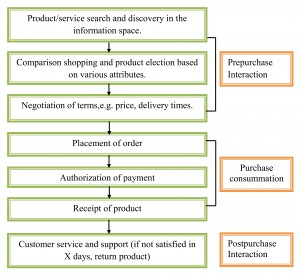On-line mercantile models from customer perspective
The on-line consumer expects quality,convenience,value,low price and control.To meet these expectations and understand the behavior of the online shopper,there is a need for a business process model that provides a standard product/services purchasing process from an interactive services and merchandising point of view.
Consumer mercantile activities can be grouped into three phases prepurchase preparation,purchase consummation and postpurchase interaction.
- The prepurchase preparation phase includes search and discovery for set of products in the large information space capable of meeting customer requirements and product selection from the smaller set of products based on attribute comparison.
- The purchase consummation phase specifies the flow of information and documents associated with purchasing and negotiation with merchants for suitable terms,such as price,availability,and delivery dates; and electronic payment mechanisms that integrate payment into the purchasing process.
- The post purchase interaction phase includes customer service and support to address customer complaints,product returns and product defects.

Consumer Mercantile Activities
1. Pre-Purchase Preparation:
From the consumer point of view any major purchase can be assumed to involve some amount of pre purchase deliberation. Pre-purchase deliberation is defined as elapsed time between the consumer’s first thinking about buying and actual purchase itself. Information search should constitute the major part of duration but comparison of alternatives and price negotiations would be included in continuously evolving information search and deliver process. To deliberate, consumers have to be watchful for the new or existing information which are essential for purchase decision process.
Information on consumer characteristics with reduced purchase deliberation time can be quite valuable when attempting to target, selective communications to desired audience properly. Thus not much attention have been paid to this important research area which may dictate success or failure of online shopping. Consumers can be categorized into three types:
i. Impulsive buyers
Impulsive buyers: these buyers purchase the product quickly.
ii. Patient buyers
Patient buyers: who purchase products after making some analysis or comparison.
iii. Analytical buyers
Who do substantial research before making the decision to purchase product or services.
2. Purchase Consumption:
After identifying the product to be purchased by the buyer and the seller must interact in some way ( e-mail, on-line) to carry out the mercantile transactions. The mercantile transaction is defined as the exchange of information between the buyer and seller followed by necessary payment depending upon the payment model mutually agreed on, they may 5 IIMC interact by exchanging currently i.e. backed by the third party such as the central bank, master card, visa card etc. A single mercantile model will not be sufficient to meet the needs of everyone. In very general terms a simple mercantile protocol would require the following transaction where the basic flow remains the same .
i. Through e-mail, online the buyer contacts the vendors to purchase a product or service. This might be done online through e-mail (or) through e-catalogue etc.
ii. Vendor states the price.
iii. Buyer and vendor may or may not engage in a transaction.
iv. If satisfied buyer authorizes payment to the vendor with an encrypted transaction containing the digital signature.
v. Vendor contacts the billing service of the buyer to verify the encrypted authorization for authentication.
vi. Billing service decrypts the authorization and checks the buyer account balance and puts a hole on the amount transfer.
vii. Billing service give the vendor green signal to deliver the product.
viii. On notification of adequate funds to cover financial transaction, vendor delivers the goods to buyer or in the case of information purchase provides a crypto key to unlock the file.
ix. on receiving the goods the buyer signs and delivers receipt. Vendors then tell billing service to complete the transaction.
x. At the end of the billing cycle buyer receives a list of transactions.

